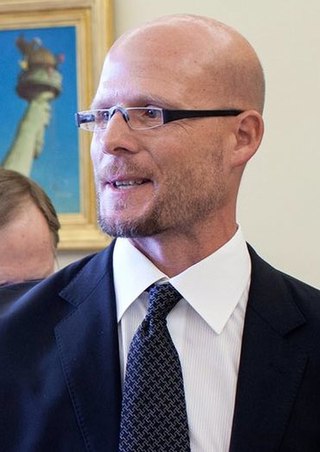
Afghan Girl is a 1984 photographic portrait of Sharbat Gula, an Afghan refugee in Pakistan during the Soviet–Afghan War. The photograph, taken by American photojournalist Steve McCurry near the Pakistani city of Peshawar, appeared on the June 1985 cover of National Geographic. While the portrait's subject initially remained unknown, she was identified by early 2002: Gula, an ethnic Pashtun from Afghanistan's Nangarhar Province, was a 12-year-old child residing in Pakistan's Nasir Bagh.

João Silva is a Portuguese-born South African war photographer. He is the last working member of the Bang-Bang Club, a group of photographers who covered South Africa from the time of Nelson Mandela's release from prison in 1990, to the country's first multiracial elections in 1994. He has worked in Africa, the Balkans, Central Asia, Russia, and the Middle East.
Alfred Khumalo, better known as Alf Kumalo, was a South African documentary photographer and photojournalist.

Greg Marinovich is a South African photojournalist, filmmaker, photo editor, and member of the Bang-Bang Club.

Véronique de Viguerie is a French photojournalist. She was noted for covering a story about an Afghan guerrilla group responsible for the Uzbin Valley ambush.

Lynsey Addario is an American photojournalist. Her work often focuses on conflicts and human rights issues, especially the role of women in traditional societies. In 2022, she received a Courage in Journalism Award from the International Women's Media Foundation (IWMF).
Bibi Aisha is an Afghan woman who fled from an abusive marriage she was forced into as a teenager, but was caught, jailed, mutilated and left to die as revenge for her escape. She was later rescued by aid workers and her story was featured in American news as an example of the effects of the Taliban's reign of terror on women. As of 2014, she lives in Maryland as the adoptive daughter of an Afghan-American couple and has received reconstructive surgery.
Daniel Berehulak is an Australian photographer and photojournalist based in Mexico City. He is a staff photographer of The New York Times and has visited more than 60 countries covering contemporary issues.
Goran Tomašević, is a Serbian photographer. Working for Reuters, he has spent more than 20 years travelling around the globe to cover the world's biggest stories.

Rula F. Saadah Ghani is a former first lady of Afghanistan and wife of former president of Afghanistan Ashraf Ghani.
Nikki Kahn is a documentary photographer based in California. She won the Pulitzer Prize for Breaking News Photography in 2011.

Xenia Deli is a Moldovan-American model. She lives in Los Angeles, California. She has been featured on several fashion magazine covers, including Elle, FMD Magazine and Sport Illustrated of South Africa. She also starred in music videos, including "Thinking About You" and Justin Bieber's "What Do You Mean?" in 2015.
Aryn Baker is an American journalist who is Time magazine's Africa correspondent. She was previously based in Beirut, Lebanon, for Time as the Middle East bureau chief, and has been a correspondent in Pakistan and Afghanistan.
James Oatway is a South African photojournalist. He was the Chief Photographer of the Sunday Times until 2016. His work focuses mainly on political and social issues in Africa, migration and people affected by conflict.

David P. Gilkey was a U.S. photojournalist for National Public Radio in the United States, for whom he covered disasters, epidemics and war.

Ruth Seopedi Motau is a South African photographer currently living and working in Johannesburg, South Africa. Motau was the first black female photographer who was employed by a South African newspaper as photo editor. Her photography focuses on social documentary influenced by photojournalism and the marginalisation of black people and communities.

Danish Siddiqui was an Indian photojournalist based in Delhi, who used to lead the national Reuters multimedia team and was Chief Photographer India. He received his first 2018 Pulitzer Prize for Feature Photography, as part of the Reuters team, for documenting the Rohingya refugee crisis. In 2021, he was killed while covering a clash between Afghan security forces and Taliban forces near a border crossing with Pakistan. His second Pulitzer was awarded posthumously in 2022 for documenting the COVID-19 pandemic.
Sharbat Gula is an Afghan woman who became internationally recognized as the 12-year-old subject in Afghan Girl, a 1984 portrait taken by American photojournalist Steve McCurry that was later published as the cover photograph for the June 1985 issue of National Geographic. The portrait was shot at Nasir Bagh, Pakistan, while Gula was residing there as an Afghan refugee fleeing the Soviet–Afghan War. Despite the photograph's high global recognition, Gula's identity remained unknown until 2002, when her whereabouts were verified and she was photographed for the second time in her life. Having lived and raised a family in Pakistan for 35 years, Gula was arrested by Pakistani authorities in 2016 and subsequently deported to Afghanistan in 2017 on the charge of possessing forged identity documents. However, in November 2021, Gula was granted asylum in Italy, three months after the Taliban takeover of Afghanistan.

Andrew Parsons is a British professional photographer who has worked with the Conservative Party and, as a civil servant, in close liaison with the four of the five most recent Prime Ministers: David Cameron, Boris Johnson, Theresa May and Liz Truss.











